Jim Grant shoots, and range reviews the FightLite MCR belt-fed upper for AR15 lowers.
U.S.A. -(AmmoLand.com)- I love all bad-ass belt-fed weapons like the FightLite MCR; They’re just so damn cool. Sure, you could argue that a magazine-fed rifle is more practical, lighter, and compact, but if you’ve ever seen the look on Animal Mother’s face in Full Metal Jacket, you know exactly how it feels to wield one.
In fact, my experience with belt-fed weapons is limited to a Russian PKM and an FN M249, and while both were near-religious experiences, I never expected to realistically have one myself unless I hit the lottery. After all, a transferrable M249 (or likely a Minimi)- when you can actually find them – is north of $500,000! This fact and the price of military-issued M249 SAWs are the likely impetus for the FightLite MCR’s development.
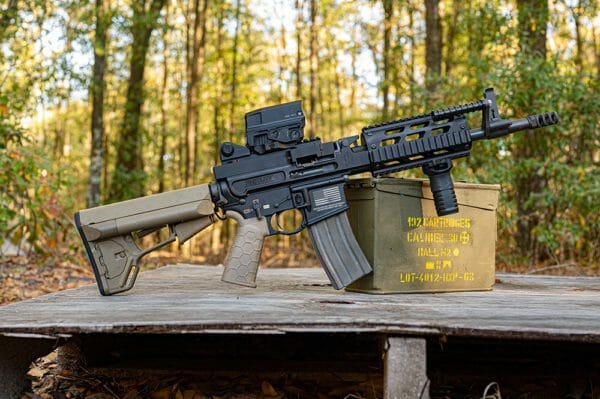
But the MCR is more than just a budget SAW, so let’s take a closer look and see what makes it so special.
FightLite MCR Upper
The FightLite MCR is a lightweight, closed-bolt, belt-fed, short-stroke piston-driven semi-or-fully-automatic upper receiver for the AR-15. Both the full and semi-auto versions are compatible with any semi-automatic AR lower, but function in only semi-automatic mode unless the shooter has a transferrable full-auto trigger pack or a registered lighting link. (The link only works in the semi-auto-only version that incorporates a bolt carrier cut to Colt SP01 specifications.)
One of the cooler features of the MCR is how it’s not just a modified AR upper, but a purpose-built SAW replacement. This is why both versions can feed from either a standard M249 SAW belt or a STANAG magazine. It’s also why the gun incorporates quick-change barrels that allow shooters to swap them out during extended firing sessions where the gun can overheat while providing suppressive fire.
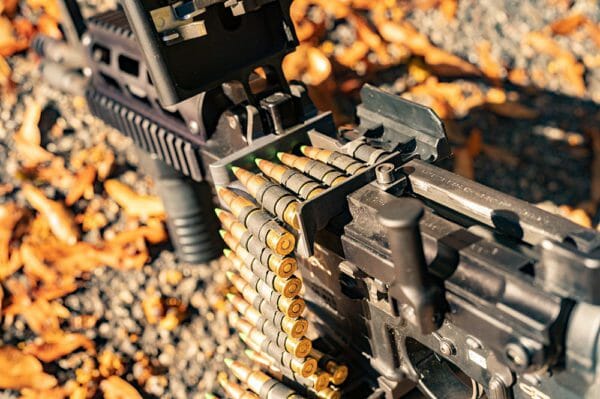
To replace the barrel, a shooter needs only to clear the action and lock it open by holding the bolt release while charging the action. Then press the barrel release tab just forward of the receiver top rail, and finally pull forward (towards the muzzle) on the barrel swap handle. Installing a replacement barrel is simply the same procedure in reverse.
Installing the MCR
Although my time with belt-fed firearms is somewhat limited, adapting to the MCR was fairly straightforward and became second nature pretty quickly. One thing that was a little unexpected, was the installation process for the FightLite MCR upper. I had originally assumed that like nearly every other AR upper receiver group, the installation consisted of popping out two takedown pins, replacing the upper, and reinstalling said pins. But there’s actually a little more complicated than that.
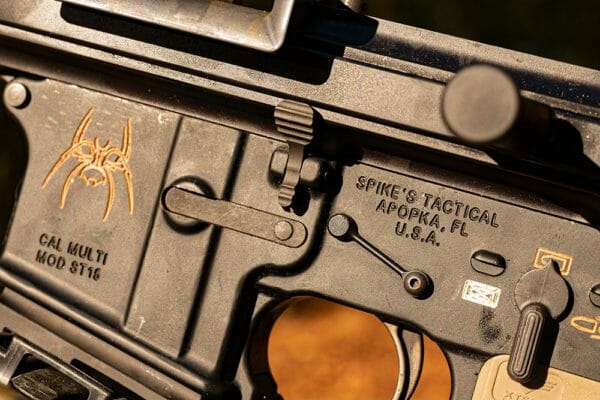
To start things off, a shooter should replace their existing AR-15 lower’s recoil buffer and spring with the ones provided by FightLite with the MCR. Doing so is very easy and doesn’t require any tools. The other step is more difficult and requires a shooter to replace their bolt catch with a proprietary extended one.

While most AR experts utilize a punch and a piece of cardboard or even cloth to protect the lower receiver while driving the roll pin in, I just took an old furniture nail and ground off the tip – but I also wrapped it in an old piece of holster leather since I ended up installing the catch on a friend’s very expensive transferrable M4 lower.
After that, simply put the MCR on top of the host AR lower, and you’re almost ready to roll!
Loading the FightLite MCR
Anyone who has ever run an M249 SAW can load the MCR in their sleep – the manual of arms is very similar. But for those of you without trigger time behind a belt-fed beast, here’s the quick and dirty version.
To load the FightLite MCR, first push the tray cover release forward toward the muzzle, then flip up the tray cover. Visually check to make sure there are no obvious signs of malfunction or damage, then draw your ammunition belt across the fed tray and align the forwardmost round to the chamber before closing the tray cover.

This requires a little finesse, but if you’re using a polymer lead that goes on the end of the belt, you can just drop the entire thing across the feed tray and be done with it.
Once the round is aligned and the tray closed, charge the MCR’s action or release the bolt. The gun is now loaded and chambered.
FightLite MCR Performance and Verdict
For the test, I ran the MCR on both a friend’s SBR lower and another friend’s transferrable, select-fire M4 lower. Across some 1,000 rounds of 5.56mm ammunition (800 rounds of 62gr green tip and 200 rounds of 55 gr FMJ), the MCR encountered around five malfunctions without cleaning. All of these issues stemmed from the gun being very hot and only occurred after the first 500 rounds were fired, leading me to believe they were caused by a combination of heat and carbon build-up.
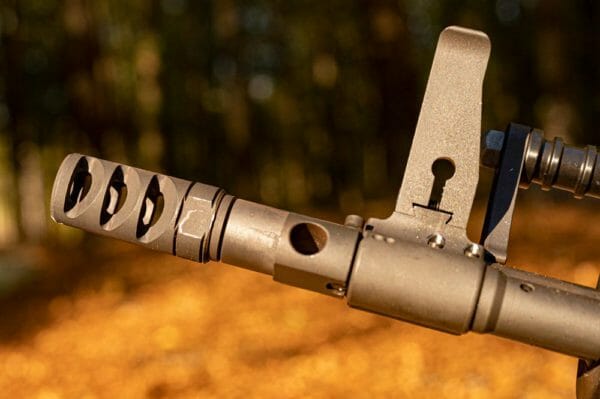
Regarding accuracy, the gun could squeeze out two-MOA groups with either barrel using military-grade ammunition. Meaning that if a shooter wanted to run match rounds through a belt fed and burn money faster than Bloomberg shoving unwanted gun control down the American people’s collective throats, they could do so for an increase in accuracy. But personally, I don’t see the point.
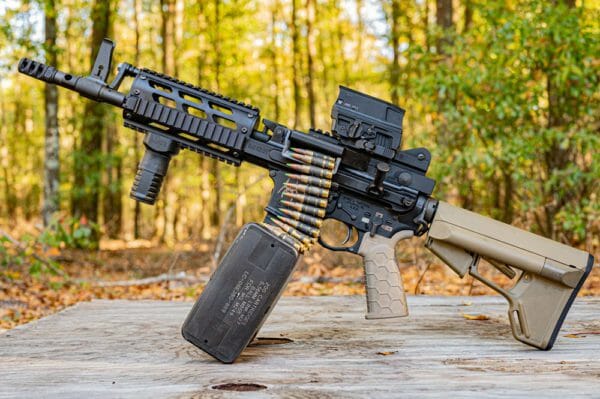
Overall, with an MSRP of around $8,000, the Fightlite MCR is by no means ‘cheap’. Not in price and certainly not in construction or build quality. Rather, it’s a purpose-built LMG or belt-fed semi-auto that does exactly what it set out to do: beat the M249 SAW in terms of both price and overall weight. Sure, it’s not cheap, but it’s incredibly more affordable, coupled with a registered drop-in auto sear when compared to a factory transferable belt-fed machinegun.
About Jim Grant
Jim is one of the elite editors for AmmoLand.com, who in addition to his mastery of prose, can wield a camera with expert finesse. He loves anything and everything guns but holds firearms from the Cold War in a special place in his heart.
When he’s not reviewing guns or shooting for fun and competition, Jim can be found hiking and hunting with his wife Kimberly, their son, and their dog Peanut in the South Carolina low country.


